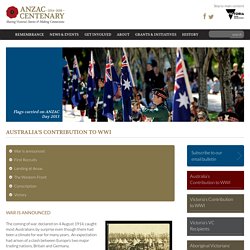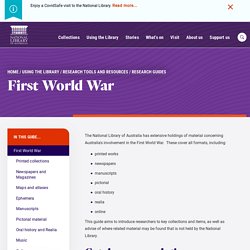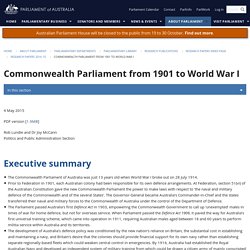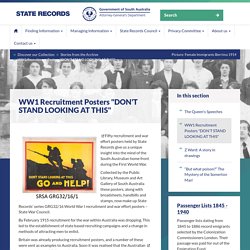

Australia's Contribution to WWI. War is announced Horse lines at Broadmeadows Military Camp.

Pictures Collection, State Library of Victoria. The coming of war, declared on 4 August 1914, caught most Australians by surprise even though there had been a climate for war for many years. An expectation had arisen of a clash between Europe’s two major trading nations, Britain and Germany. Australia was in the middle of an election campaign when war came. Labor won the Federal Election and became an enthusiastic ‘win-the-war’ party in government.
Find out more about Australia’s Prime Ministers First recruits Pictures Collection, State Library of Victoria. The recruits were wildly popular in their various marches and parades in each of the capital cities and as the first troopships departed Australian shores in late October 1914 there were large crowds on hand to say farewell. Although some Australians misbehaved and were sent home, the vast majority accepted that a soldier’s life can be pretty tough. Landing at Anzac Conscription. ANZAC Day Commemoration Committee. Aust. Propaganda Posters WW1. Australian War Memorial. Australian women of the first world war – in pictures. World War I and Australia 1914 to 1918. Posters: World War I Posters, Australia. National Archives of Australia. National Library of Australia. The National Library of Australia has extensive holdings of material concerning Australia's involvement in the First World War.

These cover all formats, including: printed worksnewspapersmanuscriptspictorialoral historyrealiaonline This guide aims to introduce researchers to key collections and items, as well as advise of where related material may be found that is not held by the National Library. Use the Catalogue standard search to find titles, authors or subjects.
If you get too many results, use the options under 'Narrow search' on the right of the results page to display only the items you're interested in.To see what you can view from home, use the link to 'NLA digital material' on the right of the results page.If you need to widen your search, click on the subject headings in an item's Catalogue record to find other material related to that subject. To search for general works about the First World War, select the Browse alphabetically tab, then subjects. Commonwealth Parliament from 1901 to World War I. 4 May 2015 PDF version [1.9MB] Rob Lundie and Dr Joy McCann Politics and Public Administration Section The Commonwealth Parliament of Australia was just 13 years old when World War I broke out on 28 July 1914.

Prior to Federation in 1901, each Australian colony had been responsible for its own defence arrangements. At Federation, section 51(vi) of the Australian Constitution gave the new Commonwealth Parliament the power to make laws with respect to ‘the naval and military defence of the Commonwealth and of the several States’.
Contents Executive summary Introduction Australia before World War I Australia as a nation Parliament and Australia’s defence Defence Acts, 1903 and 1904 Developing an Australian defence force Defence Act 1909 Naval Defence Act 1910 The eve of war Parliament Parties and prime ministers Elections. Australian Soldiers, Memorials and Military. Completion of the Thai Burma Railway On the Thailand Railway, 1Harold Abbott, 1946 Over a year after construction first began, the two tracks of the Thai Burma railway were connected at Kon Kuta, Thailand on October 16th, 1943.

The railway spanned 420 kilometres, consisting of more than 600 bridges and passing through near impenetrable rock and jungle. This incredible feat of engineering came at the cost of at least 2,815 Australian lives, not to mention a further 11,000 Allied prisoners and 75,000 Asian labourers.[1] When Singapore fell to the Japanese, about 22,000 Australians were taken prisoner. The working conditions were appalling and work itself was perilous and unrelenting. Women at war - World War I and Australia. War begins for Australia - World War I and Australia - Research Guides. State Library of Victoria. WW1 Recruitment Posters "DON'T STAND LOOKING AT THIS"
Fifty recruitment and war effort posters held by State Records give us a unique insight into the mind of the South Australian home front during the First World War.

Collected by the Public Library, Museum and Art Gallery of South Australia these posters, along with broadsheets, handbills and stamps, now make up State Records’ series GRG32/16 World War I recruitment and war effort posters – State War Council. By February 1915 recruitment for the war within Australia was dropping. This led to the establishment of state based recruiting campaigns and a change in methods of attracting men to enlist. Britain was already producing recruitment posters, and a number of these were sent as examples to Australia. Soon it was realised that the Australian governments would also need to engage a poster artist and advertising writer to “decorate stations, streets and hotels with similar bold productions, appealing for more men in the fighting line.”
Women were also targeted by these posters.